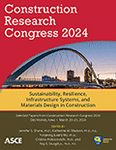Finite Element Analysis of Structural Lining Materials for Pipeline Rehabilitation
Publication: Construction Research Congress 2024
ABSTRACT
The resilience of pipeline infrastructure is pivotal to the safety of the industries and residents. Aging issues of pipelines, such as time-induced deterioration, pose a significant potential for leaks or even explosions, with devastating consequences for lives and properties. To address the challenges, epoxy resin liner emerges as a practical trenchless solution to rehabilitate pipeline with minimal interference to surrounding environment. In addition to pure epoxy, we introduce epoxy/carbon nanotube (CNT) composite as an alternative structural lining material to assess the improvement brought about by nano additives. The research investigates the effectiveness of structural liners in underground pipeline maintenance and rehabilitation through a three-dimensional finite element analysis (FEA) model. Computational models are constructed to simulate steel gas pipes and structural liners under various pressurized conditions. Through a comprehensive parametric study, we explored the effect of various factors, including liner thickness and the addition of CNTs, on the mechanical performance of both the pipeline and the structural liner. The findings guide trenchless construction and maintenance procedure, ultimately enhancing the safety and reliability of pipeline infrastructure.
Get full access to this article
View all available purchase options and get full access to this chapter.
REFERENCES
Bigdeli, F., Javidi, M., and Pakshir, M. 2021. “A comparative study of mechanical properties and corrosion behavior of fusion-bonded epoxy and liquid epoxy coatings and their service life in drill pipe applications.” Materials Research Express, 8(2), 025506.
Farrag, K. 2015. Evaluation of Structural Liners for the Rehabilitation of Liquid and Natural Gas Piping Systems.
Fridleifsson, I. B. 2003. “Status of geothermal energy amongst the world’s energy sources.” Geothermics, 32(4–6), 379–388.
Green, K. P., and Jackson, T. 2015. Safety in the transportation of oil and gas: Pipelines or rail? JSTOR. Vancouver, BC: Fraser Institute.
Hilberink, A., Gresnigt, A. M., and Sluys, L. J. 2010. “A finite element method approach on liner wrinkling of snug fit lined pipe.” The Twentieth International Offshore and Polar Engineering Conference, Beijing, China.
Ji, H. W., Yoo, S. S., Kim, J., and Koo, D. D. 2018. “The mechanical properties of high strength reinforced cured-in-place pipe (CIPP) liner composites for urban water infrastructure rehabilitation.” Water, 10(8), 983.
Jin, F.-L., Li, X., and Park, S.-J. 2015. “Synthesis and application of epoxy resins: A review.” Journal of Industrial and Engineering Chemistry, 29, 1–11.
Kaseem, M., Hamad, K., and Ko, Y. G. 2016. “Fabrication and materials properties of polystyrene/carbon nanotube (PS/CNT) composites: A review.” European Polymer Journal, 79, 36–62.
Kausar, A., Rafique, I., and Muhammad, B. 2016. “Review of applications of polymer/carbon nanotubes and epoxy/CNT composites.” Polymer-Plastics Technology and Engineering, 55(11), 1167–1191.
Kennedy, J. L. 1993. Oil and gas pipeline fundamentals. Tulsa, OK: PennWell Books.
Kundalwal, S. I., and Rathi, A. 2020. “Improved mechanical and viscoelastic properties of CNT-composites fabricated using an innovative ultrasonic dual mixing technique.” Journal of the Mechanical Behavior of Materials, 29(1), 77–85.
Lahelin, M., Annala, M., Nykänen, A., Ruokolainen, J., and Seppälä, J. 2011. “In situ polymerized nanocomposites: Polystyrene/CNT and Poly (methyl methacrylate)/CNT composites.” Composites Science and Technology, 71(6), 900–907.
Law, T. M., and Moore, I. D. 2007. “Numerical modeling of tight fitting flexible liner in damaged sewer under earth loads.” Tunnelling and Underground Space Technology, 22(5–6), 655–665.
Lu, H., Iseley, T., Behbahani, S., and Fu, L. 2020. “Leakage detection techniques for oil and gas pipelines: State-of-the-art.” Tunnelling and Underground Space Technology, 98, 103249.
Mahendran, M. 2007. “Applications of finite element analysis in structural engineering.” Proceedings of the International Conference on Computer Aided Engineering, 38–46. Chennai, India.
Morsi, K., and Esawi, A. 2007. “Effect of mechanical alloying time and carbon nanotube (CNT) content on the evolution of aluminum (Al)–CNT composite powders. Journal of Materials Science, 42, 4954–4959.
Roylance, D. 2001. Finite element analysis. Department of Materials Science and Engineering, Massachusetts Institute of Technology. Cambridge, MA.
Schilde, C., Schlömann, M., Overbeck, A., Linke, S., and Kwade, A. 2015. “Thermal, mechanical and electrical properties of highly loaded CNT-epoxy composites–A model for the electric conductivity.” Composites Science and Technology, 117, 183–190.
Shimamura, Y., Oshima, K., Tohgo, K., Fujii, T., Shirasu, K., Yamamoto, G., Hashida, T., Goto, K., Ogasawara, T., and Naito, K. 2014. “Tensile mechanical properties of carbon nanotube/epoxy composite fabricated by pultrusion of carbon nanotube spun yarn preform.” Composites Part A: Applied Science and Manufacturing, 62, 32–38.
Shou, K. J., and Chen, B. C. 2018. “Numerical analysis of the mechanical behaviors of pressurized underground pipelines rehabilitated by cured-in-place-pipe method.” Tunnelling and Underground Space Technology, 71, 544–554.
Wang, L., Tu, J. P., Chen, W. X., Wang, Y. C., Liu, X. K., Olk, C., Cheng, D. H., and Zhang, X. B. 2003. “Friction and wear behavior of electroless Ni-based CNT composite coatings.” Wear, 254(12), 1289–1293.
Yu, M.-F., Lourie, O., Dyer, M. J., Moloni, K., Kelly, T. F., and Ruoff, R. S. 2000. “Strength and breaking mechanism of multiwalled carbon nanotubes under tensile load.” Science, 287(5453), 637–640.
Zarghamee, M. S., Erbay, Ö. O., Eggers, D. W., and Kendall, D. R. 2006. “Ultimate strength prediction of steel liners using nonlinear finite element analysis.” In: Proc., Pipelines 2006, ASCE, Reston, VA, pp. 1–9.
Information & Authors
Information
Published In
History
Published online: Mar 18, 2024
Authors
Metrics & Citations
Metrics
Citations
Download citation
If you have the appropriate software installed, you can download article citation data to the citation manager of your choice. Simply select your manager software from the list below and click Download.
